User Account Control, or just UAC is a part of the Windows security system which prevents apps from making unwanted changes on your PC. By default, the UAC prompt shows a dialog with the Yes and No buttons for administrators. In Windows 10, you can change this behavior. The UAC prompt can be automatically rejected, or can be set to appear on the secure desktop, or set to a variety of other options. Let's review them.
Advertisеment

Since Windows Vista, Microsoft added a new security feature called User Account Control (UAC). It tries to prevent malicious apps from doing potentially harmful things on your PC. When some software tries to change system-related parts of the Registry or the file system, Windows 10 shows an UAC confirmation dialog, where the user should confirm if he really wants to make those changes. Usually, the apps that require elevation are related to the management of Windows or your computer in general. A good example would be the Registry Editor app.
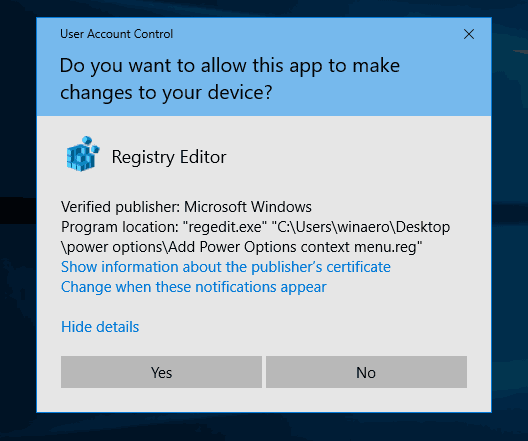
The UAC comes with different security levels. When its options are set to Always notify or Default, your Desktop will be dimmed. The session will be temporary switched to the secure Desktop without open windows and icons, containing only an elevation prompt by the User Account Control (UAC).
Members of the Administrators user group have to confirm or reject the UAC prompt without providing extra credentials (UAC consent prompt). Users without administrative privileges have to additionally enter valid credentials for a local administrator account (UAC credential prompt).
There is a special security policy in Windows 10 that allows changing the UAC prompt behavior for administrators.
The Supported Options
- Elevate without prompting: Allows administrative accounts to perform an operation that requires elevation without requiring an extra confirmation.
- Prompt for credentials on the secure desktop: The UAC prompt will ask for a user name and password. To continue, the user must provide valid credentials. The prompt appears on the secure desktop.
- Prompt for consent on the secure desktop: The UAC prompt will appear on the secure desktop with the Yes and No buttons.
- Prompt for credentials: The user will be prompted to enter a user name and password of an an administrative account. The must enter valid credentials. The screen won't be dimmed.
- Prompt for consent: The UAC prompt will appear on regular (non-dimmed) desktop with the Yes and No buttons.
- Prompt for consent for non-Windows binaries (Default): The UAC prompt appears on the secure desktop with the Yes and No buttons for executable files not signed by Microsoft, i.e. for third-party apps.
If you are running Windows 10 Pro, Enterprise, or Education edition, you can use the Local Security Policy app to change the policy. All editions of Windows 10, including Windows 10 Home, can use a Registry tweak mentioned below.
To Change UAC Prompt Behavior for Administrators in Windows 10,
- Press Win + R keys together on your keyboard and type:
secpol.msc
Press Enter.
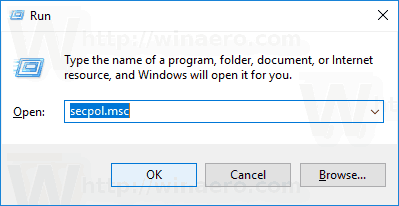
- Local Security Policy will open. Go to User Local Policies -> Security Options.
- On the right, scroll to the option User Account Control: Behavior of the elevation prompt for Administrators.
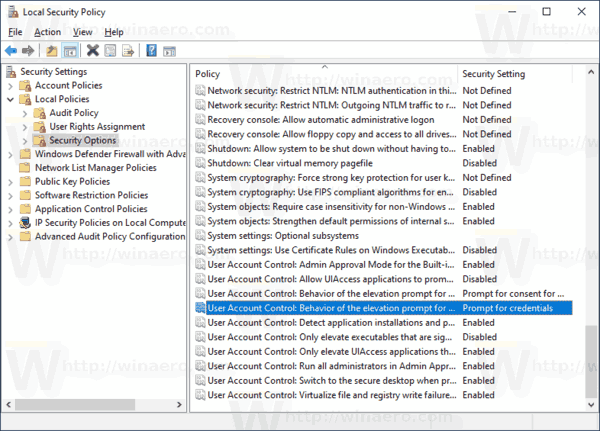
- Double-click on this policy to change its value.
- Select the UAC behavior you want to set for administrators.
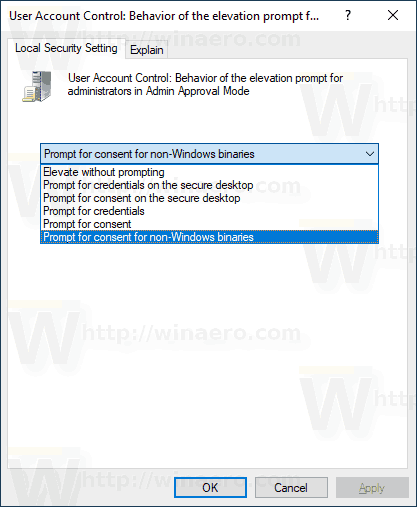
If your Windows edition doesn't include the secpol.msc tool, you can apply a Registry tweak as described below.
Enable UAC Prompt for Built-in Administrator with a Registry Tweak
- Open Registry Editor.
- Go to the following Registry key:
HKEY_LOCAL_MACHINE\SOFTWARE\Microsoft\Windows\CurrentVersion\Policies\System
Tip: See how to jump to the desired Registry key with one click.
If you do not have such a key, then just create it.
- Here, modify or create a new 32-bit DWORD value ConsentPromptBehaviorAdmin. Note: Even if you are running 64-bit Windows you must still create a 32-bit DWORD value.
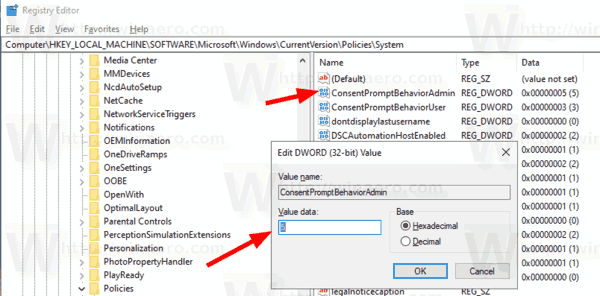 Set its value data to one the following values:
Set its value data to one the following values:- 0 - Elevate without prompting
- 1 - Prompt for credentials on the secure desktop
- 2 - Prompt for consent on the secure desktop
- 3 - Prompt for credentials
- 4 - Prompt for consent
- 5 - Prompt for consent for non-Windows binaries
- Restart Windows 10.
To save your time, you can download the following ready-to-use Registry files.
Download Registry files
The undo tweak is included.
That's it.
Related articles:
- Change UAC Prompt Behavior for Standard Users in Windows 10
- Disable Dimmed Secure Desktop for UAC Prompt in Windows 10
- Hide Administrator Account From UAC Prompt in Windows 10
- Enable CTRL+ALT+Delete Prompt for UAC in Windows 10
- Create elevated shortcut to skip UAC prompt in Windows 10
- How to change UAC settings in Windows 10
- Fix Yes button disabled in UAC dialogs in Windows 10, Windows 8 and Windows 7
- How to turn off and disable UAC in Windows 10
Support us
Winaero greatly relies on your support. You can help the site keep bringing you interesting and useful content and software by using these options:

Hello Sergey.
Thank you for this tutorial.
Though, I have a problem, which is that I don’t have “User Account Control: Behavior of the elevation prompt for Administrators.” listed
This is what I have
https://prnt.sc/direct/ncgpao
Any tips?
Thank you once again.
Hi.
Which Windows 10 version you are running?
Hello Sergey.
I am running Windows 10 1809 Build 17763.437 Education Edition x64
Please repair download link, bechose link not exist.
Thank you.. It worked for me .. Thank you very much for the post!…